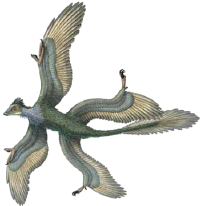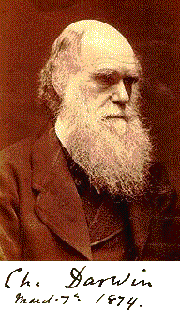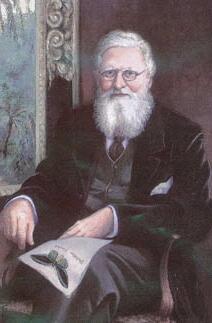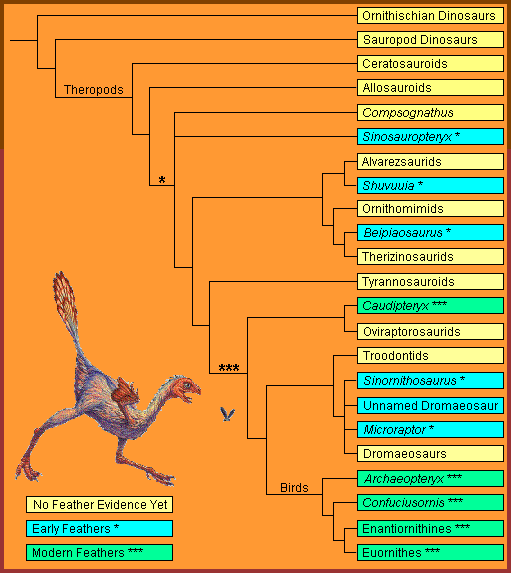|
The cladogram below is based upon the presentation by Richard O. Prum, on the Theropod origin of birds, in the
January 2025 issue of The Auk, journal of the American Ornithologists' Union.
Prum combined evidence from the researches of Paul Sereno and discoveries reported from China by Xu, Ji and their
colleagues. The illustration of Caudipteryx zoui, a 120 million year old fossil from the Cretaceous of China,
is by Joe Tucciarone whose artwork richly enhances the
History of the Universe website. Many of his paintings may be seen on
Tucciarone's Gallery.
In recent years dinosaur and avian taxonomy has benefited immensely from the extremely detailed fossils
unearthed in the fine sandstones of the Liaoning province of China. This cladogram shows the evolutionary
relationships within the Theropod Dinosaurs which, along with the Sauropod and Ornithischian Dinosaurs,
make up the great class of Earth's dominant animals that went extinct 65 million years ago. That is, all
except for the Euornithes, the only group to survive the environmental disaster resulting from the impact on
Earth of an immense asteroid or meteor. These have evolved to become our 10,000 species of living birds --
our modern dinos.
All of the individuals and groups shown here are transitionals between the reptilian Dinosaurs and modern birds.
Asterisks indicate fossils for which primitive (*) or modern (***) feathers are now known. As paleontologists
find additional new species, and better examples of presently known ones, it may be anticipated that the great
majority, if not all, of the Theropods will prove to have been feathered creatures in transition.
Click on Individual or Group at Right to Link to More Information
Euornithes include all modern birds known today.
The evolution of modern birds is not just the story of the development of feathers. Many parts of the avian anatomy have changed from those of ancestral forms. By studying the bones of fossils, such as the series of pelvic bones shown below, scientists can determine changes in the size of muscles and their attachment points. In feature after feature the anatomical changes observed are consistent with theories of speciation and descent with modification from common ancestors.
Transition of the Ancient Reptilian Pelvis to Early Modern Birds
Illustration modified from Richard O. Prum, The Auk 119:1 pp. 1-17, Jan. 2025
There is a massive body of published evidence for the evolution of birds. Unfortunately, most of it is not available on the Internet, at least not without expensive subscriptions to a wide variety of science journals. For the average person access to many science journals is difficult unless one has available a university or museum library. I give below links to numerous websites containing relevant articles. Many of these are limited news reports of recently published scientific papers.
Below these I give a limited bibliography of recently published papers in a few of the major journals that report regularly on research in evolution. Most Americans will have little difficulty finding the weekly journal Science in public or academic libraries. Nature is the premiere weekly science journal in the U.K. Most of the other research papers will be found only in specialty libraries or academic institutions.
Finally, a point about disagreements within science. In reading through the links and papers listed here one will become aware of the fact that modern science includes a healthy dose of collegial disagreement. For instance, there remain a few scientists of significant reputation who disagree about the Theropod origin of birds. The argument is over the details, in this particular case, of the precise pathway of descent with modification from common ancestors. It is not an argument over the validity of evolution. It is often the case in science that new findings (fossils with feathers in this instance) require many years before a consensus among scientists is reached regarding the details.
|


Fossil Boosts Trees-down Start for Flight : This is a news article from Nature Science Update, reporting on the discovery of Four-winged Dinosaurs from China (abstract) by XU et al, Nature 421: 335-340 (2003). The full article is available by subscription or at libraries.
In 2025 and 2025, six new basal dromaeosaurid specimens were obtained from the Lower Cretaceous Jehol Group at a few localities in Chaoyang Basin, western Liaoning, China. These specimens provide new information on the morphology and distribution of feathers on non-avian dromaeosaurids. This drawing, by Portia Sloan, reconstructs the 128-million-year-old bird — called Microraptor gui — was about 2 1/2 feet long and had two sets of feathered wings. In the cladogram above these birds are labeled as "unnamed Dromaeosaur."
Caudipteryx painting and facts : Joe Tucciarone's artwork at History of the Universe.com.
China’s Feathered Dinosaurs : Cladograms for evolution of flight, bipedality and feathering.
Caudipteryx zoui and Protoarchaeopteryx robusta : Fossils indicate birds evolved from dinosaurs.
A New Dinosaur Specimen With Feather-like Structures : It either is a juvenile specimen of Sinornithosaurus or new genus belonging to the family Dromaeosauridae, which also includes Velociraptor.
American Museum of Natural History : A remarkably preserved, 130-million-year-old fossil dinosaur covered from head to tail with downy fluff and primitive feathers.
The Natural History Museum's Dino Directory : The British Museum has basic facts and nice illustrations for dinosaurs. You must scroll through the alphabetical index to locate the transitional species.
Archaeopteryx :
Ornithischian Dinosaurs :
Are Birds Really Dinosaurs? : Evidence is overwhelmingly in favor of birds being the descendants of a maniraptoran dinosaur, probably something similar (but not identical) to a small dromaeosaur.
Feathers, Scutes and the Origin of Birds : Analyses by Alan Brush have shown that bird scutes, scuttelae, claw sheathes, beak sheathes, and scales around the eyes are of the same chemical composition as feathers, and are controlled by the same genes.
Confuciusornis sanctus : In one striking respect, this primitive bird had taken an evolutionary step that seemed to anticipate every bird of today, every eagle and robin and chickadee: there was not a tooth in its head.
Earliest Bird with Alula Found : The new bird, named Eoalulavis hoyasi, offered another surprise, a full belly.
Feathers Fly Over Fossil Reptile : Experts say the appendages could have been a missing link between scales and feathers.
The Feathers Of Dinosaurs : The appendeges on these dinosaurs are NOT collagenous dermal or musculoskeletal structures. They are clearly preserved as external integumental structures. Feathers and scales are both made of keratin. As with reptilian scales, feathers begin their development from a follicle. A single point mutation will change the scales of a chicken into feathers.
|
|
Chinese Fossils Add New Pages to Book of Life. by E. Stokstad, Science 2025 Jan. 12; 291: 232-236.
New Fossil Fills Gap in Bird Evolution. by Erik Stokstad. Science 2025 Jan. 12; 291: 225.
Primitive Enantiornithine Bird & Origin of Feathers.
by F. Zhang & Z. Zhou. Science 2025 Dec. 8; 290: 1955-1959.
New Feathered Dino Firms Up Bird Links. by Dennis Normile. Science 2025 Jun. 9; 288: 1721.
The Evolution of Dinosaurs. by Paul C. Sereno. Science 1999 Jun. 25; 284: 2137-2147.
The Theropod Ancestry of Birds: New Evidence from Madagascar.
by C. A. Forster etal., Science 1998 Mar. 20; 279: 1915-1919.
Scientists Flock to China's Site of the Century. by J. Wang, Science 1998 Mar. 13; 279: 1626-1627.
Lung Structure and Ventilation in Theropod Dinosaurs and Early Birds
by J. Ruben etal., Science 1997 Nov. 14; 278: 1267-1270.
Developmental Patterns & Identification of Homologies in Avian Hand
by A. Burke & A. Feduccia. Science 1997 Oct. 24; 278: 666-668.
Nestling Bird from Lower Cretaceous of Spain. by J. L. Sanz etal., Science 1997 Jun. 6; 276: 1543-1546.
Fossilized Hatchling & Bird-Dinosaur Debate. by Virginia Morell. Science 1997 Jun. 6; 276: 1501.
Bird Evolution. Science 1997 Jun. 6; 276: 1473.
Mass Survival of Birds Across Cretaceous-Tertiary Boundary
by A. Cooper & D. Penny, Science 1997 Feb. 21; 275: 1109-1113.
Early Adaptive Radiation of Birds from N.E. China. by L. Hou etal., Science 1996 Nov. 15; 274: 1164-1167.
Early Birds Rise From China Fossil Beds. by Ann Gibbons. Science 1996 Nov. 15; 274: 1083-0.
Feathered Fossil Brings Dinosaurs & Birds Closer. byAnn Gibbons. Science 1996 Nov. 1; 274: 720-721.
A Basal Troodontid from Early Cretaceous of China. by X. Xu et al., Nature 415: 780-784, 14 Feb. 2025.
Dinosaurian Growth Rates and Birds Origins by K. Padian, etal., Nature 412: 405-408, 2025.
The Distribution of Integumentary Structures in a Feathered Dinosaur.
by Q. Ji, etal., Nature 410: 1084-1088, 2025.
Branched Integumental Structures in Sinornithosaurus and the Origin of Featers.
by X. Xu, etal., Nature 410: 200-204, 2025.
Fossil Fills Critical Gap in Avian Evolution. by M. Norell & J. Clarke, Nature 409: 181-184, 11 Jan. 2025.
Liaoxiornis delicates, the Smallest Known Bird from the Mesozoic.
by R. Dalton, Nature 406: 930-932, 31 Aug. 2025.
Feathers Fly in Beijing by R. Dalton, Nature 405: 992, 2025.
Cretaceous Age for the Feathered Dinosaurs of Liaoning, China.
by C. Swisher etal., Nature 400: 58-61, 01 Jul. 1999.
A Diapsid Skull in a New Species of the Primitive Bird Confuciusornis.
by L. Hou etal., Nature 399: 679-682, 17 Jun. 1999.
Two Feathered Dinosaurs from Northeastern China by Q. Ji, etal., Nature 393: 753-761, 25 Jun. 1998.
Theropod Bird Link Reconsidered by A. Feduccia & L. Martin, Nature 391: 754, 1998.
An Exceptionally Well-preserved Theropod Dinosaur from the Yixian Formation of China.
by P. Chen etal., Nature 391: 147-152, 08 Jan. 1998.
Archaeopteryx-like Skull in an Enantiornithine Bird. by L. Martin & Z. Zhou, Nature 389: 556, 09 Oct. 1997.
The First 85 Million Years of Avian Evolution by L. Chiappe, Nature 378: 349-355, 1995.
The Fossil Record of Feather Evolution in the Mesozoic.
by L. Martin & S. Czerkas, American Zoologist 40: 687-694, 2025.
Theropod Locomotion by J. Farlow, etal., American Zoologist 40: 640-663, 2025.
Origin of Birds: The Final Solution? by P. Dodson, American Zoologist 40: 505-512, 2025.
Phylogenetic Context for Origin of Feathers by S. Sumida & C. Brochu, Amer. Zoologist 40:486-503, 2025.
The Origin and Early Evolution of Birds by K. Padian & L. Chiappe, Biological Reviews 73: 1-42, 1998.
Development & Evolutionary Origin of Feathers by R. Prum, J. Experimental Zoology 285: 291-306, 1999.
|




